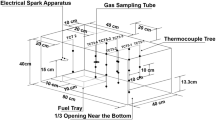Abstract
This study is a qualitative exploration of backdraft phenomena. Backdraft is defined as a rapid deflagration following the introduction of oxygen into a compartment filled with accumulated excess pyrolyzates. A scenario describing the physical and chemical fundamentals underlying backdraft phenomena is presented. A half-scale apparatus, designed to avoid dangerous overpressures, was used to obtain data from backdraft experiments. A gas burner supplied a 150 kW natural gas fire in a 1.2 m high, 1.2 m wide, 2.4 m long compartment with a small, 25 mm high, 0.3 m wide vent to ambient at floor level. Significant unburnt fuel accumulates in 180 seconds, when a hatch covering a 0.4 m high, 1.2 m wide vent, centered on a short wall, is opened, simulating a window breaking due to thermal stresses. The propagation across the compartment of the cold density-driven flow, which enters through the new opening, is called a “gravity current.” This gravity current carries a flammable mixed layer to a spark located near the burner on the opposite wall. The rapid deflagration that results upon ignition of the mixed layer is the backdraft. A compartment fire model is used to calculate conditions in the compartment before the vent opens. The hypothesized scenario appears to be confirmed by the deflagrations and exterior fire balls observed in these preliminary experiments.
Similar content being viewed by others
References
Pagni, P. J., and Shih, T. M., “Excess Pyrolvzates,” 16th Symposium (Int'l) on Combustion, The Combustion Institute, Pittsburgh, Penn., 1976, pp. 1329–1343.
Pagni, P.J., “Diffusion Flame Analyses,”Fire Safety Journal, 3 (1980/81), pp. 273–286.
Pagni, P.J., and Joshi, A.A., “Glass Breaking in Fires,”Fire Safety Science: Proceedings of the Third International Symposium, Elsevier Science Publishing, London, 1991, pp. 791–802.
Keski-Rahkonen, O., “Breaking of Window Glass Close to Fire,”Fire and Materials, 12 (1988), pp. 61–69.
Russell, D., “Seven Fire Fighters Caught in Explosion,”Fire Engineering, 136 (1983), pp. 20–23.
Bowen, J.E., “Flashover/Backdraft Explosive Situation,”Western Fire Journal, 34 (1982), pp. 33–38.
“Fatal Mattress Store Fire at Chatham Dockyard,”Fire, 67 (1975), pp. 388.
Croft, W.M., “Fires Involving Explosions: A Literature Review,”Fire Safety Journal, 3 (1980/81), pp. 3–24.
Steward, P.D.C., “Dust and Smoke Explosions,”National Fire Protection Association Quarterly, 7 (1914), pp. 424–428.
Dunn, V., “Beating the Backdraft,”Fire Engineering, 141 (1988), pp. 44–48.
Woolley, W.D., and Ames, S.A., “The Explosion Risk of Stored Foamed Rubber,”Fire International, 50 (1975), pp. 45–54.
Burklin, R.W., and Purington. R.G.,Fire Terms: A Guide to Their Meaning and Use, National Fire Protection Association: Boston, Mass., 1980.
Jones, W.W., “A Review of Compartment Fire Models,”NBSIR 83- 2681, National Bureau of Standards: Gaithersburg, Md., 1983.
Mitler, H.E., “The Harvard Fire Model,”Fire Safety Journal, 9 (1985), pp. 7–16.
Friedman, R., “Survey of Computer Models for Fire and Smoke,” Factory Mutual Research Corporation: Norwood, Mass., 1991.
Emmons, H.W., “The Calculation of a Fire in a Large Building,”ASME Paper No. 81-HT-2, American Society for Mechanical Engineers, New York, 1981.
Simpson, J.E., “Gravity Currents in the Laboratory, Atmosphere, and Ocean,”Annual Review of Fluid Mechanics, 14 (1982), pp. 213–234.
FIeischmann, C. M., and McGrattan, K., “Modeling Compartment Gravity Currents,” to be published.
Britter, R. E., and Simpson, J.E., “Experiments on the Dynamics of a Gravity Current Head,”Journal of Fluid Mechanics, 88 (1978), pp. 223–240.
Simpson, J.E., and Britter, R.E., “The Dynamics of the Head of a Gravity Current Advancing over a Horizontal Surface,”Journal of Fluid Mechanics, 94 (1979), pp. 477–495.
Zalosh, R. G., “Explosion Protection,”SFPE Handbook of Fire Protection Engineering, P. DiNenno, ed., National Fire Protection Association: Quincy, Mass., 1988, pp. 2–88 to 2–105.
Factory Mutual Engineering Corporation, “Damage-Limiting Construction,”Loss Prevention Data Sheet 1–44, Norwood, Mass., 1991.
Neoceram Super Heat-Resistant Glass for Industrial Use, Nippon Electric Glass Co., Ltd.
Sugawa, O., Kawagoe, K., Oka, Y., and Ogahara, I., “Burning Behavior in a Poorly Ventilated Compartment Fire—Ghosting Fire,”Fire Science and Technology, 9 (1989), pp. 5–14.
Phillips, H., “Flame in a Buoyant Methane Layer,” 10th Symposium (Int'l) on Combustion, The Combustion Institute, Pittsburgh, Penn., 1965, pp. 1277–1283.
Fleischmann, C.M., Pagni, P.J., and Williamson, R.B.,Salt Water Modeling of Compartment Gravity Currents, to be published.
Mitler, H.E., and Rockett, J.A., “Users' Guide to FIRST, a Comprehensive Single-Room Fire Model,”NBSIR 87-3595, National Bureau of Standards: Gaithersburg, Md., 1987.
Mitler, H.E., and Emmons, H.W., “Documentation for CFC V, the Fifth Harvard Computer Fire Code,”Home Fire Project Technical Report No. 45, Harvard University: Cambridge, Mass., 1981.
Rockett, J.A., Morita, M., and Cooper, L. Y., “Comparison of NBS/Harvard Vl Simulations and Full-Scale, Multi-Room Fire Test Data,”NBSIR 87-3567, National Bureau of Standards: Gaithersburg, Md., 1987.
Zukoski, E. E., Kubota, T., and Cetegen, B., “Entrainment of Fire Plumes,”Fire Safety Journal, 3 (1980/81).
Mitler, H. E., “The Physical Basis for the Harvard Computer Fire Code,”Home Fire Project Technical Report No. 45, Harvard University: Cambridge, Mass., 1981.
Quintiere, J. G., Steckler, K., and Corley, D., “An Assessment of Fire-Induced Flows in Compartments,”Fire Science and Technology, 4 (1984), pp. 1–14.
Author information
Authors and Affiliations
Rights and permissions
About this article
Cite this article
Fleischmann, C.M., Pagni, P.J. & Williamson, R.B. Exploratory backdraft experiments. Fire Technol 29, 298–316 (1993). https://doi.org/10.1007/BF01052526
Issue Date:
DOI: https://doi.org/10.1007/BF01052526




